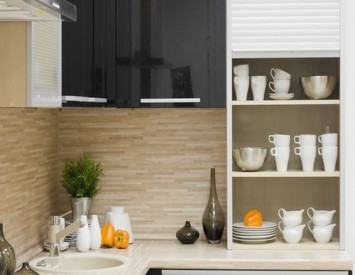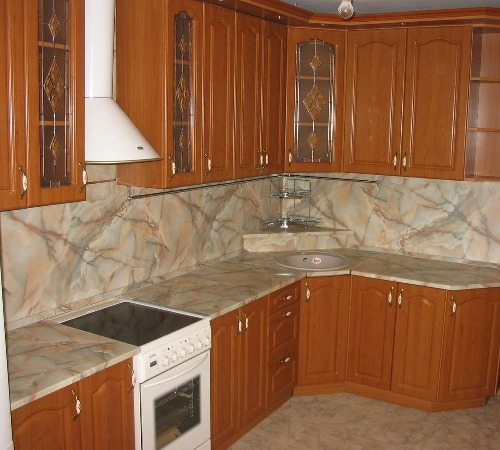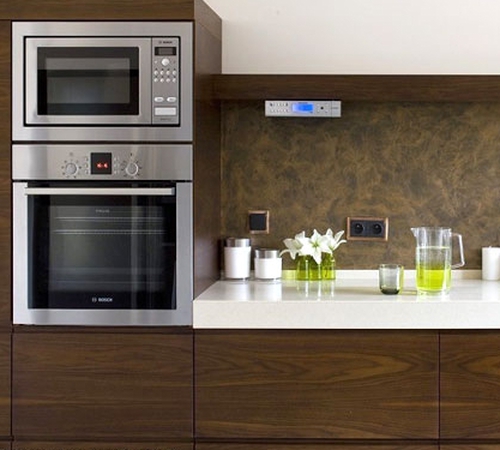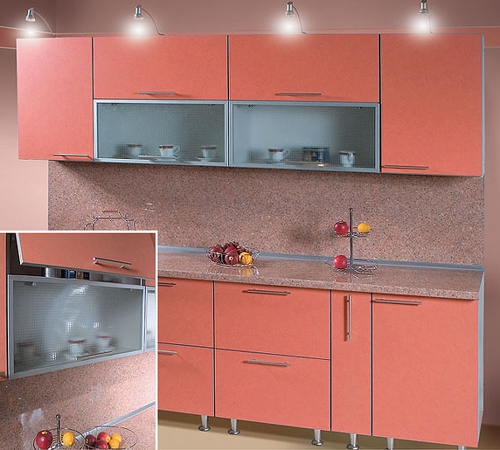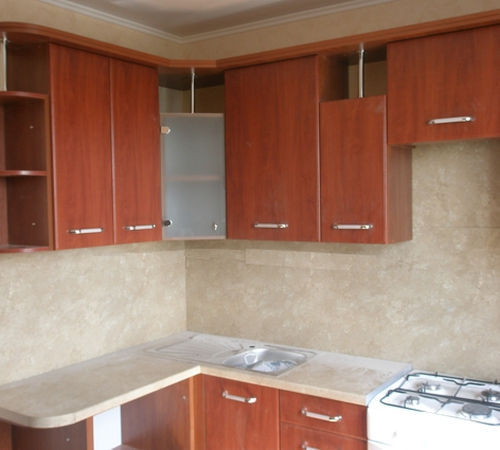The main place of any kitchen is of course a plate, it is there that exquisite culinary masterpieces are born. But cooking involves pollution not only the plate itself, but also the space around. Smoke, steam, spray of fat and oil leave a very noticeable mark. To make the process of caring for the stove as comfortable as possible, use the apron for the kitchen.
Content
Advantages of MDF
This material has been known for a long time. Get it by pressing sawdust under high pressure and temperature. Celebrate its following positive properties:
- not susceptible to temperature extremes,
- practicality,
- durability,
- naturalness,
- distribution of moisture with proper processing.
If earlier the MDF plates were monotonous and used more in construction than in the production of furniture, now the technology has stepped far ahead. Firstly, it was possible to make the thickness of the plates less, now it varies from two to five sentiments, and secondly, the outside is laminated, which gives it an aesthetic appearance and makes it possible to use it for external work.
Standard tiles are no longer in fashion. The use of PVC is extremely undesirable, since the material is susceptible to mechanical damage, in addition, spots that cannot be removed appear on it quickly. It is also fair in relation to the tree. Therefore, there are only two options left:
- artificial stone,
- MDF.
In terms of technical characteristics, they are approximately identical, but the apron for the kitchen from MDF is much cheaper.
Choice of MDF stove
Despite the fact that there are quite a lot of different MDF panels in the construction market, only two are suitable for decorative work:
- laminated MDF,
- openced MDF.
As an option, an apron from MDF is decorated independently, but this procedure has nothing to do with savings, since the total cost will be much higher than the price of ready -made plates.
The laminated MDF is covered with a special melamine film, which makes the surface not only beautiful, but also practical. In order to damage it, it is necessary to really make efforts, the option of random violation of the integrity of the cover is excluded.
Such plates are a pressed block, on the back of the construction cardboard or pressed paper, and with a front covered with decorative vinyl. On sale there are a variety of options, from simple monotonous patterns, to these works of art. To compose a visual idea of \u200b\u200bhow the apron from MDF looks like, a photo will help.
The veneered MDF is much less common. Since its front side is covered with natural veneer, it is most often used for furniture. Using it in the kitchen is a controversial question. If cooking occurs 1-2 times a week, then the material will withstand the load, but with daily use of the slab, the veneer will very quickly lose its appearance and begin to crack and peel off. This is in no way connected with the quality of the product, and is explained by the purely physical properties of the material.
Preparatory work
Before installing an apron from MDF, it is necessary to carry out some starting work:
- draw a drawing,
- make a calculation of the necessary materials,
- prepare a tool,
- lease the surface of the wall.
The drawing does not imply an abstract drawing of the future apron, with the indications of size, but a full -scale graphic visualization of the updated kitchen. This is necessary in order to understand how much the selected option will fit into the interior. Quite often, the goods on the window look much more spectacular than in life.
In addition to the MDF plates itself, you may need:
- plaster,
- primer,
- confirmates,
- liquid nails.
It is advisable to buy everything you need at a time, especially if you order delivery.
From the tools will come in handy:
- spatula,
- dry putty dishes,
- level,
- set of hexagons,
- drill,
- a gun for liquid nails.
Although, an apron from MDF does not need a perfectly flat surface of the wall, some work in this direction will still have to be done. Most often, I just knock down the elements too accepted, but if there are too many of them, it is easier to melt the wall.
The kitchen apron from the DFM is a whole panel and theoretically allows you to play any irregularities with linings. Thus, the distance to the wall is increased by 7-15 cm and the upper edge is used as a shelf for storing spices and other small containers. This option is acceptable only in the kitchen of a square or close shape to it. In elongated rooms, where the working area is located, as a rule, on one of the longer walls, this reception will steal too much space and turn the room into a subway car.
How to make an apron from MDF
In fact, this work will need only a few hours and a minimum of effort. Plates are extremely convenient in installation, but given their dimensions, two people require, one of whom will help to support the panel, and the second to fix it.
Installation of a kitchen apron from MDF is performed in three versions:
- confirmation to the wall,
- confirmers to a wooden frame,
- liquid nails.
Even if you buy a sheet of minimum thickness, it will still take two centimeters of the square. Therefore, confirmation fastening directly to the wall is an ideal solution for small kitchens. The work is performed as follows:
- at a distance of 60 cm in length and 15 in height, holes are marked and drilled for confirmation (at the base they should be slightly wider so that the bolt comes in a flush),
- further, the panel is applied to the wall and notes are made through the holes (despite the fact that this method is already for many years, it still remains the most reliable and allows us to exclude the possibility of error),
- dowel, into which confirmation are screwed into the walls, are inserted into the walls.
Of the shortcomings of this method, the following are distinguished:
- a perfectly flat surface is needed,
- it is impossible to perform sound insulation.
Nevertheless, this is the easiest and fastest way, in addition, such an apron is very easy to dismantle. From a visual point of view, the only problem is the hats of the bolts, it is solved using decorative linings.
Installation of the apron on a wooden frame is carried out according to the same principle. For support beams, bars with a section of 5x5 cm are used. At the output, this allows you to remove the front of the apron from the wall by at least seven centimeters and use the upper part as a shelf.
This is relevant for large and medium kitchens, with an area of \u200b\u200b10 square meters. m. Technology avoids the need to align the walls. In addition, the space between the apron and the stone is filled with construction foam, which allows you to achieve perfect sound insulation and creates the effect of additional insulation.
The apron of MDF is also allowed using liquid nails. This is the only way that allows you to do without visible violations of a monolithic surface. By and large, the entire technology is described on the label label, where it is said how to work with it.
As a general rule, it looks like this:
- apply liquid nails to the back of the MDF of the sheet,
- check the level,
- remove for 5-10 minutes,
- attach back
- fix with stands and leave in this state for 12-18 hours.
As an option, some masters advise dividing a continuous sheet into 3-4 separate blocks, in which special grooves are drank. This allows you to hide the confirmation, but instead of decorative linings, seams appear. Therefore, the choice is purely aesthetic.
Another option is the fastening of the console type, when a special mount is screwed to the wall, on which the kitchen apron is put on. In the theory of total weight, MDF is enough to make the design reliable, but in practice different situations are possible. In addition, this option is suitable only for walls with a thickness of 15-20 cm, since in a narrower masonry, the console will simply tear out of the brick, while thoroughly destroying the wall.
Tips for the use of MDF apron
MDF panels for the apron of the kitchen is the fastest, inexpensive and fashionable way to decorate the room. Performing not only practical, but also aesthetic functions, it should look as beautiful as possible. Therefore, a few words should be said about their decoration and care process.
The only additional element that may be needed is the overlay on the upper edge. Most often put aluminum corners. There are quite a lot of varieties for every taste on sale. If the apron is decorated in the form of a shelf, then the design will be needed by an ordinary wooden board or an even platoon for the door. To fasten the base, it is necessary to screw to the wall on the corner for every 30 cm of the shelf. The board is attached to the plate with screws, and just lies on the corners.
Caring for MDF is quite simple, any detergents are suitable except abrasive. Problem areas are best laundered with dishes. As a preventive cleaning, windows for windows are perfect, as they create an antistatic film on the surface of melanine, repulsing dust and dirt.
